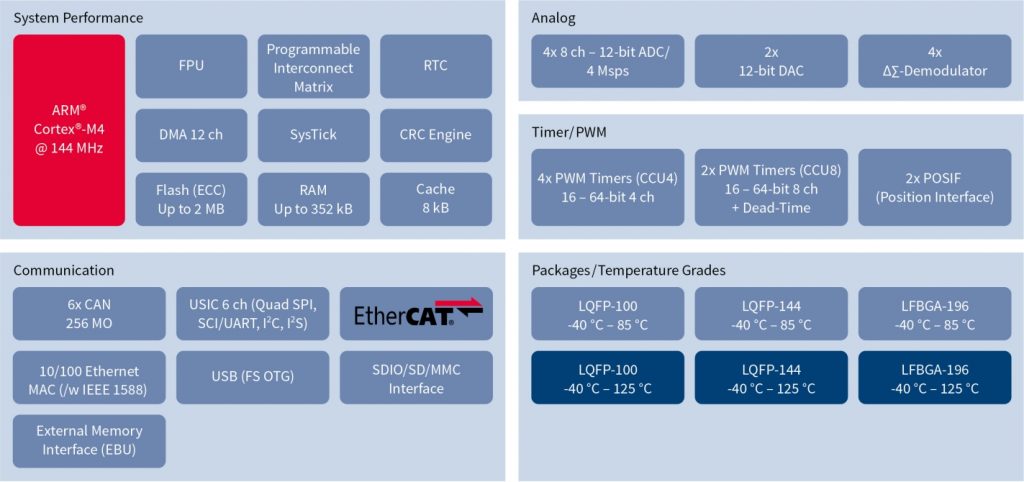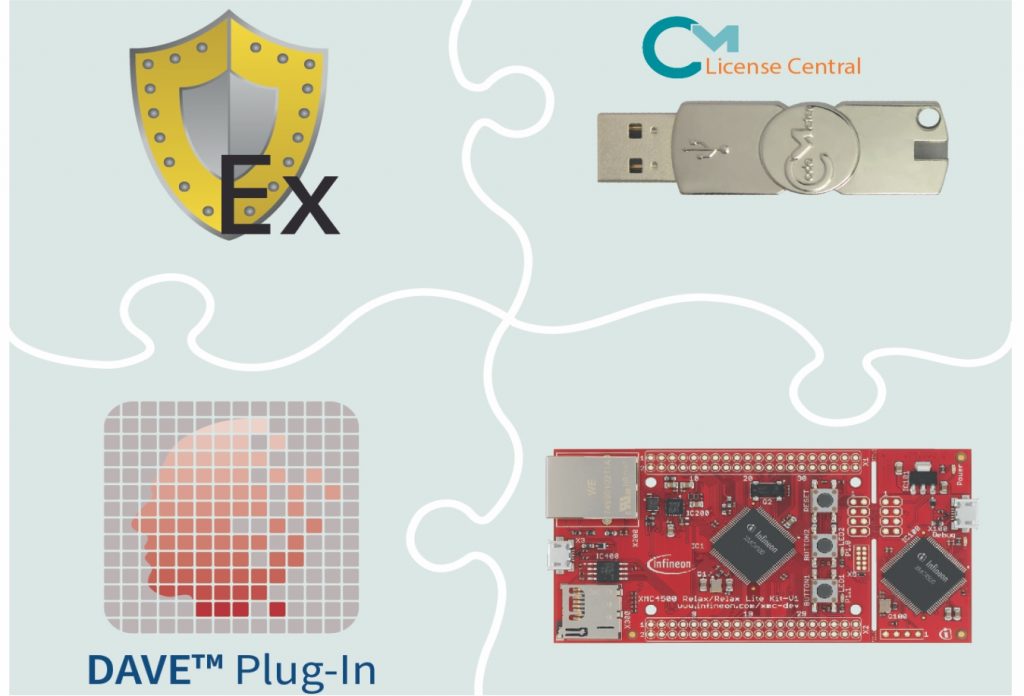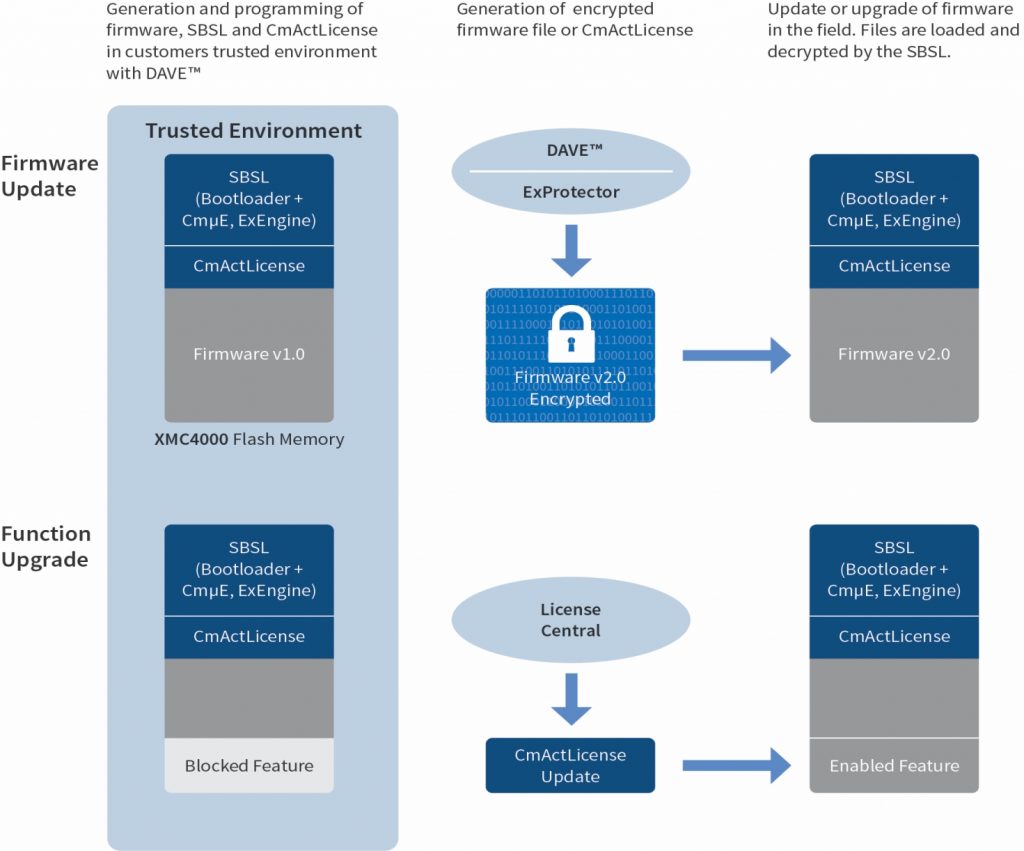The outlook for IoT applications is impressive. The Internet of Things should make roughly a 15 trillion US dollar contribution to the global gross social product in the next twenty years (source: General Electric), with an installed base of 28.1 billion units by 2020 (source: IDC). But these figures are not only impressive, but simultaneously alarming when one considers the security aspects associated with the IoT revolution. It is important to take advantage of these developments while still ensuring both functional safety and data security. Security aspects affect all the systems involved, from PCs, IPCs, embedded systems, mobile devices, and PLCs to the microcontrollers used. Wibu-Systems, working with Infineon, has now introduced the CodeMeter μEmbedded, an efficient firmware protection for systems based on the XMC4000 microcontroller, in particular in applications such as IoT or Industry 4.0.
The “Internet of Things” (IoT), with its different variants such as Industry 4.0, information and communications technology, smart homes, and networked automobiles, requires a high level of security.

Typical application cases include the authentication or licensing of components based on their unique identity, monitoring and securing system integrity, the protection of data and communications, as well as secure updates and upgrades. To build trust in new services and technologies, IP protection is also essential. Corresponding solution concepts require embedded system solutions based on secure hardware that protects the infrastructure and components from attacks, fraud, and sabotage. Since essentially all embedded systems integrated into IoT concepts are based on microcontrollers, this is the first level on which the corresponding protective functions must rely.
The general challenge in the implementation of maximum security in microcontroller applications lies in the fact that the solution must also be usable under harsh industrial conditions and easy to integrate. CodeMeterμEmbedded was developed based on the proven CodeMeter solution from Wibu-Systems for the protection, licensing, and security of systems. It particularly addresses the security aspects of firmware updates and functional extensions of microcontroller-based systems. The corresponding keywords here are code integrity, license monitoring, and protection from reverse engineering and copying of program code.
The implementation of CodeMeterμEmbedded was carried out in collaboration with Infineon and is based on the 32-bit microcontroller family XMC4000.

CodeMeter μEmbedded extends the standard development tools to provide secure firmware updates and functional extensions in embedded systems based on the XMC4000.
Secure firmware updates and functional upgrades
Microcontrollers are increasingly used in frequently networked applications such as pumps, motor drives, sensors with field bus connections, and similar systems. In these applications, the secure loading of updates and/or functional upgrades is a significant security-critical aspect. The task of CodeMeter μEmbedded is to ensure secure loading of updates into the XMC4000 microcontroller and to introduce new functionality even in insecure environments. In highly networked and intelligent systems such as those in IoT, these important aspects must be considered:
- Only trustworthy code may be loaded into the controller. The code must be encrypted during transmission and loading. This is done using a unique key stored in the boot ROM of the controller.
- Traceable, reliable licensing must also be guaranteed while loading the code onto the controller. It should be possible to block or activate additional functionality of the microcontroller.
- The code may only be loaded and decrypted on authorized (licensed) controllers. It is essential to ensure that use on an unlicensed controller or emulator is prevented.
Integrated into the development environment
CodeMeterμEmbedded protects the firmware of the controller against manipulation, reverse engineering, and copying during updates. OEMs who develop software for controllers can also extend system functionality.

The user can load a new encrypted firmware version from an external environment into the controller. This triggers encryption through the development environment – such as DAVE 4.0 from Infineon. Therefore, an appropriate plug-in is installed in DAVE.
DAVE Version 4 is available for download as a free development tool. This professional Eclipse-based development platform supports the user in developing software, from evaluation to final product. Among other things, an extensive peripheral- and application-oriented, component-based code repository is available. DAVE also generates appropriate code for the peripherals of XMC microcontrollers. With DAVE, the user can take advantage of commercial third-party tools for ARM to translate, link, and load the C source code configured and generated in DAVE onto the MCU. That covers the entire development cycle from evaluation to first prototype to final product, giving users maximum freedom in fast, efficient, platform-oriented software and product development.
After transfer to the XMC4000 microcontroller, the firmware is decrypted and stored in the flash memory. The XMC4000 handles the decoding. The microcontroller can generate a request with its unique “fingerprint” for later upgrades. This encrypted request is then transmitted to the manufacturer, who generates an appropriately licensed update and sends it back. The licensing update transmitted to the microcontroller can be used to provide new licenses or new functionality.

The integration of this solution into DAVE as a plug-in (Figure 4) permits its use in a variety of application cases based on a technology or development environment with efficient firmware protection. Functional upgrades can be carried out without changes to the firmware, while secure firmware updates are possible even in insecure environments. The solution is also easy to handle and customer-friendly, while using the latest in encryption technology.
Protecting application code in microcontrollers
CodeMeterμEmbedded is a security variant specifically developed for Field Programmable Gate Arrays (FPGAs) and microcontrollers. The software is characterized by extremely small space requirements (footprint) of less than 60 kbytes. This was achieved by reducing the functional scope of the solution to the absolute minimum. The licenses generated are compatible with any CodeMeter variants. Each license is bound to a unique ID of the FPGS or microcontroller. Licenses can be activated in the production environment directly during production, or afterwards by file exchange in a “features on demand” system.
CodeMeterμEmbedded can also be used for the secure storage of symmetric and asymmetric keys. The key material is placed in protected storage and can be used only on a device with the correct ID. Typical application cases include: License control on devices (microcontrollers and FPGAs), monitoring of production quantity by licensing of individual devices, and the secure encrypted transmission of application code to the device.
With CodeMeterμEmbedded, customers on the microcontroller family XMC4000, that uses the ARM Cortex M4 procesor,get a secure solution for updating the firmware on embedded systems already installed in the field, or to activate licensing of additional functionality.
CodeMeterμEmbeddedis compatible with CodeMeter, the security solution for PCs and embedded devices. So,one can continue to use familiar tools, such as CodeMeter License Central and the development environment DAVE .A new plug-in for DAVE offers developers a simple graphical interface for configuring the XMC4000 microcontroller and generating encrypted firmware updates or license files.
The XMC4000 family
The XMC4000 family for industrial applications is particularly well-suited for digital power converters, electrical drivetrains, and sensor applications; it supports a variety of industrial communications standards. All XMC4000 microcontrollers are qualified for temperatures up to 125 °C. They use the ARM Cortex M4 processor with built-in DSP functionality, floating point unit, Direct Memory Access (DMA), and Memory Protection Unit (MPU). The extensive peripherals include analog/mixed signal converters, high-resolution timers/PWM channels, and interfaces for all current industrial communication standards. The XMC4000 family today consists of the seven series XMC4100, XMC4200, XMC4400, XMC4500 and XMC4700 as well as XMC 4300 and XMC4800. It includes more than 80 components in VQFN, LQFN, and LFBGA packages with between 48 and 196 pins. The two series XMC4300 and XMC4800 feature on-chip EtherCAT (Ethernet for Control Automation Technology) and permit the simple, cost-effective implementation of real-time Ethernet communications and is therefore ideal for Industry 4.0 applications.
Functional safety
In addition to data security, of course, complex IoT applications must also ensure functional safety – and that is even more important in networked systems. However, the implementation is often difficult. For industrial applications that must meet functional safety requirements, there is a Safety Package available for the XMC4000 family. Ithelps in the development of TÜV-certified automation systems that must meet the requirements of Safety Integrity Levels SIL 2 and SIL 3. Also, the Safety Package assists to reduce the development time of functional safety software test libraries to just a year. It was developed for factory automation, industrial drives, and robotics applications, as well as in consideration of Industry 4.0 and IoT.
The XMC4000 Safety Package includes the XMC4000 microcontrollers and also a detailed set of documentation and a TÜV-certified software test library. The documentation includes an error mode report and a failure mode effects and diagnostic analysis (FMEDA) report, as well as the Safety Application Note. The FMEDA uses reliable FIT (failure in time) rates for the XMC4000 microcontroller.


